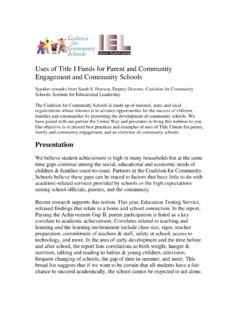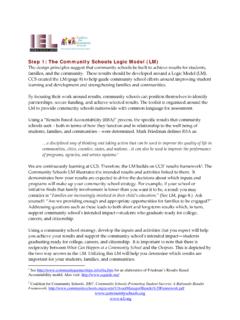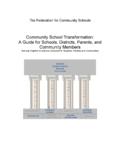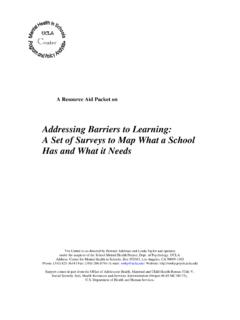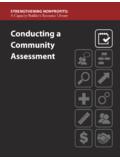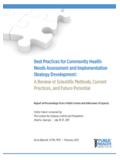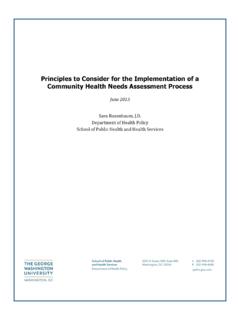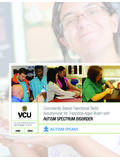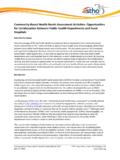Transcription of Strengthening Partnerships - Community Schools
1 Strengthening Partnerships : Community SchoolAssessment ChecklistSTRENGTHENING Partnerships : Community SCHOOL assessment CHECKLISTIn many communities, Partnerships between Schools and other Community organizations andagencies are helping to create supports that enable children and youth to learn and succeed andhelp families and communities to thrive. These Partnerships bring together diverse individuals andgroups, including principals, teachers, school superintendents, school boards, Community -basedorganizations, youth development organizations, health and human service agencies, parents andother Community leaders, to expand opportunities for children, families, and communities. Creating a successful Community school partnership is a complex, challenging, and time-consumingtask. To be effective, Partnerships need to engage in a thoughtful process to define a vision and cleargoals.
2 Partnerships need to have effective governance and management structures to ensure thatprograms operate efficiently and the partnership is responsive to Community needs. Communityschool Partnerships also need to draw from a broad range of perspectives and expertise from insidethe school as well as from other organizations and individuals within the Community . Finally, Community school Partnerships need to connect, coordinate, and leverage resources from a variety of sources to support and continue their tool contains a series of checklists to assist school and Community leaders in creating and/orstrengthening Community school Partnerships . The first checklist helps you to assess the development of your Community school partnership . The second checklist helps you to take inventory of existing programs and services in or connectedto your school that support children, youth, families, and other Community residents.
3 The third checklist helps you to catalogue the funding sources that support these programs and services. Once completed, these checklists can serve as a planning tool to develop strategies to strengthen yourpartnership, improve coordination of existing programs and services, and/or to expand current levelsof support. By Martin J. Blank and Barbara Hanson LangfordSeptember 2000I. Community School partnership AssessmentBuilding and maintaining effective Community school Partnerships requires dedicated time and ongoing attention to thecollaborative process. This checklist focuses on the processof bringing partners together and working to achieve desiredresults. This checklist can help Partnerships to focus on, assess, and improve the quality of their collaborative efforts. Our partnership has developed a clear 2 3 4 5 AgreeOur partnership has collaboratively identified the results we want to achieve for children, youth, families.
4 And our 2 3 4 5 AgreeOur partnership has successfully engaged a broad base of partners from a range of individuals and organizationsrepresenting the school and the 2 3 4 5 AgreeOur partnership has developed strategies for coordinating and linking the array of supports and opportunities for children,youth, families, and Community members that are available at or connected to the 2 3 4 5 AgreeOur partnership has established a clear organizational structure.
5 Our partnership has agreed upon the roles that individualpartners will play, and ensured that all partners understand and accept the responsibilities of those 2 3 4 5 AgreeAll partners involved in our Community school have an understanding of who the other partners are, what organizationsthey come from, and what those organizations 2 3 4 5 AgreeOur partnership regularly communicates with all partners to keep them informed about its 2 3 4 5 AgreeOur partnership engages in activities to create awareness about and increase support for the work of the 2 3 4 5 AgreeOur partnership has identified and mobilized resources (financial and other)
6 From partner organizations and other entitiesthroughout the 2 3 4 5 AgreeII. Community School Program and Service ChecklistAn important first step for school and Community leaders seeking to create or expand Community school Partnerships is to assess the broad range of resources that are currently available within or connected to their school. Some of theseprograms and services may be directly supported by the school; others may be supported by Community organizations andagencies. This checklist helps you to take inventory of the programs and services already administered by the school and its partners. Once you know what programs and services exist, your challenge is to make sure these programs and servicesare strategically coordinated to achieve desired results and to identify new programs and services that may be AdministratorSchool orCommunity-LocalIf not run by thePrograms And ServicesSchoolbasedPublicOtherschool, list nameDistrictOrganizationAgencyof partner SUPPORTS FOR SCHOOL-AGE CHILDREN AND YOUTH Academic Enrichment/ Tutoring/Remedial EducationArts, Music, and Cultural ProgramsBefore- and/or After-School ProgramsCommunity Service/Service LearningConflict ResolutionFamily Life/Personal Skills/Teen Parenting ProgramsLiteracyMentoringRecreation/Spor tsSchool NurseSubstance Abuse and/or Violence Prevention ProgramsOtherOtherProgram AdministratorSchool orCommunity-LocalIf not run by thePrograms And ServicesSchoolbasedPublicOtherschool.
7 List nameDistrictOrganizationAgencyof partnerCOMMUNITY SUPPORTSA dult Education/GED/LiteracyParenting EducationHealth EducationHealth Care and/or Dental Services Early Care and Education/ Pre-K/Head StartJob TrainingSubstance Abuse Prevention Violence PreventionMental Health ServicesFamily Support CenterOtherOtherIII. Community School Funding Source assessment Once you ve taken inventory of the current programs and services operating in or connected to your school, the next step is to identify the sources of funding that support these services. In some cases, funding may come from federal, state, orlocal government agencies. In other cases, funding may come from private sources, such as Community -based organizationsor private foundations. This assessment can be used to catalogue existing funding sources that support a Community schoolas well as to identify new funding sources to expand current programs and OF SUPPORT FOR Community SCHOOL PROGRAMS AND SERVICESS chool and/or School District( Title I) Community -Based Organizations( YMCA, Boys & Girls Club, faith-based organizations) Universities and Colleges( work study or service learning students, professional development training)Federal Funds( food and nutrition funds, 21st Century Learning Community Learning Centers, VISTA, AmeriCorp)State Funds( funds from state departments of education, health and/or human services, and juvenile justice)City or County Funds( funds from local departments of human services, parks and recreation, and juvenile justice) Private Foundations( local Community foundations, national foundations)
8 Private BusinessesPTAP articipation FeesOtherADDITIONAL RESOURCESS trengthening Community School Partnerships The Collaborative Wellness Kit, Together We Can, Institute forEducational Leadership, 202-822-8405. A Compact for Learning: An Action Handbook for Family-School- Community Partnerships , partnership for Family Involvement inEducation & US Department of Education, 800-USA-LEARN. Creating A Community Agenda: How Governance Partnerships CanImprove Results for Children, Youth, and Families. Center for theStudy of Social Policy, Washington, , 1998, to the Grassroots: Neighborhood Organizing andMobilization. A Matter of Commitment Community Collaboration Guidebook Series #6, Charles Bruner & MariaChavez, NCSI Clearinghouse, 1997, 515-280-9027. Learning Together: The Developing Field of School-CommunityInitiatives, Atelia Melaville and Martin J. Blank, The CharlesStewart Mott Foundation, 1998, 800-645-1766.
9 partnership Self- assessment Tool and Guide to Successful Public-Private Partnerships for Child Care, Child Care partnership Project, or 202-628-4200. Schools and Community Partnerships : Revitalizing Urban Schoolsand Neighborhoods, Michelle Cahill. Cross-Cities Campaign forUrban School Reform, 312-322-4880. Strong Families, Strong Schools : Building Community Partnershipsfor Learning, Department of Education, 1994, Training Guide for Organizing Collaborative Enterprises, UnitedWay of America & The Institute for Educational Leadership, 1999,202-822-8405. Resources from the Coalition for Community Schools ( or 202-822-8405 ext. 45) Community Schools : Partnerships for Excellence. May Policy Approach to Create and Sustain Community Schools OnLine: Questions and Answers about Community Schools , Vol. 1, No. 7 Community Schools for Excellence Public Education Campaign,Vol.
10 1, No. 8 Improving Community School Programs and Services Characteristics and Features of Community -Based Family SupportPrograms, Carl Dunst, Family Resource Coalition, Best PracticesProject, Commissioned Paper II, 1995, 312-341-0900, ext. Competencies for Youth Workers, A Guided Tour of YouthDevelopment, and The Handbook of Positive Youth Outcomes,Youth Development Institute. Networks for Youth Development,Fund for the City of New York, (212) 925-6675. Health is Academic: A Guide to Coordinated School HealthPrograms, Editors Eva Marx and Susan Frelick Wooley, TeachersCollege Press, 1234 Amsterdam Avenue, New York, NY Assistance & Out-of-School Time: Filling the Need, Findinga Balance, Susan O Connor & Kate McGuire, National Institute onOut-of-School Time, 1998, or Results for Children, Youth and Families: AComprehensive Guide to Ideas and Help: Where the Tube Hits theRoad: Providing Services, Supports and Opportunities that Improvethe Lives of Children, Youth, and Families, Karen Pittman &Michele Cahill, Center for Youth Development and Policy I.


